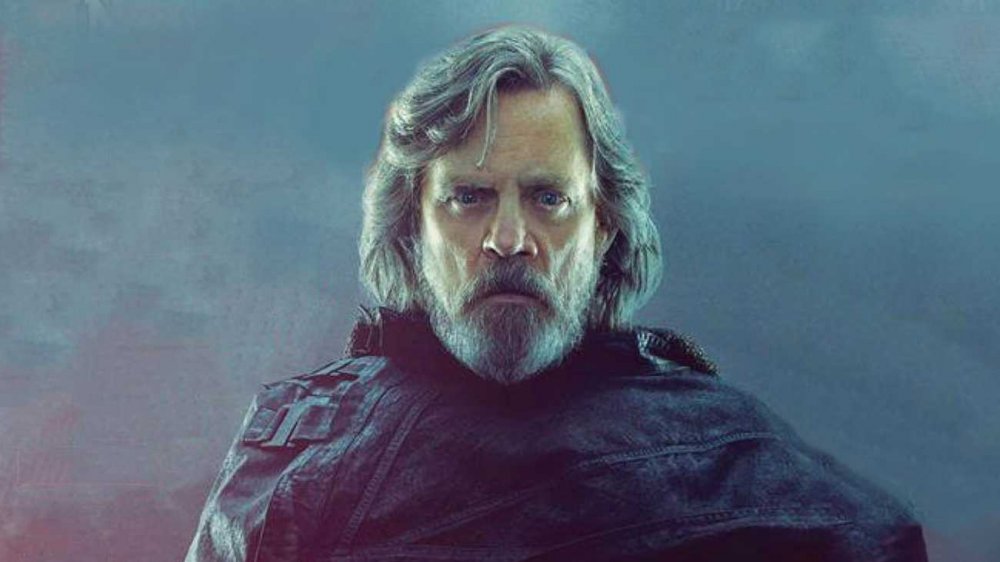Luke's Exact Cause Of Death In The Last Jedi Revealed
Contains a brief spoiler for The Rise of Skywalker
For one to rise, another must fall, and now we know precisely what befell Luke in 2017's Star Wars: The Last Jedi.
Since the 2015 launch of the Star Wars sequel trilogy launch in 2015, fans have had to watch each new installment cut down a beloved original golden-trio character — Luke Skywalker, Leia Organa, and Han Solo — one by one. In The Force Awakens, audiences saw Harrison Ford's Solo — part smuggler, part scoundrel, part hero, and full captain of the Millennium Falcon — succumb to his death by lightsaber after failing to convince his and Leia's (Carrie Fisher) only son, Kylo Ren (Adam Driver), to reject the dark side and betray Supreme Leader Snoke. In The Last Jedi, it would be Mark Hamill's Luke who died, in yet another attempt to stop Kylo Ren — born Ben Solo — during a battle between the First Order and Resistance forces.
With the recent release of Star Wars: The Rise of Skywalker — The Visual Dictionary, we now know the exact cause of death for the Tatooine farmboy whose powerful ancestry and rejection of the dark side helped make him one of the galaxy's greatest heroes to have ever lived.
At the end of Rian Johnson's The Last Jedi, fans saw Luke virtually vanish into thin air. This happened after he came to the aid of his sister General Leia Organa, Poe Dameron (Oscar Isaac), Finn (John Boyega), Rose Tico (Kelly Marie Tran), and the other Resistance fighters who were taking cover in a bunker on the remote planet of Crait, the former home to a Rebel base. Cornered by Kylo Ren and the First Order's massive army, the Resistance was facing a bleak fate — until Luke, who had just scenes before rejected Rey's pleas to return to the fight, Force-projected himself onto the planet. He then proceeded to distract his unwitting nephew until the Resistance crew could successfully escape.
Their epic face-off resulted in Kylo Ren plunging his lightsaber into Luke — an attempted kill that darkly resembled the death of Han Solo. Fortunately, the lightsaber went right through the great Jedi, and soon we can see why. Luke was still on the remote island planet Ahch-To where Rey left him, sitting on the edge of a cliff and using the Force to project himself onto Crait. After the rebels escaped, Luke dissipated from the strain of the illusion, seemingly vanishing into the Force itself. ComicBook.com first noticed that Star Wars: The Rise of Skywalker — The Visual Dictionary reveals the specifics of Luke's vanishing, an act that sees the Jedi pour "his living Force presence into the all-encompassing cosmic Force."
Luke's ability to use Force projection is based on a Similfuturus or "Doppelgänger" technique chronicled in ancient sacred texts of the Fallanassi, a religious order that first appeared in the Star Wars: The Black Fleet Crisis trilogy. Taking place 16 years after the events of A New Hope, these stories have since been de-canonized following the rebrand of the Star Wars Expanded Universe to Star Wars Legends. Yet, the visual dictionary confirms that during that pivotal Last Jedi scene between Kylo Ren and Luke on Crait, Luke (through this order's specific methodology) creates an illusion of himself that is able to be both seen and heard — one so perfect it's indistinguishable from the real Jedi Master. Unlike other versions of Similfuturus, though, the Fallanassi technique doesn't give its wielder the ability to move objects through telekinesis physically.
Through "extreme concentration and focus," Luke's presence — which allegedly "exists only in the Force" — is able to "bridge incredible distances." According to the visual dictionary, it's a transition so complete that "Luke gives his all into the Force, finding serenity in this final mortal moment" before vanishing to become "one with the great beyond." Force-projecting is not only a difficult move to pull off, but can also cause significant physical strain. As we now know, it's the reason why Luke's entire being succumbed to the Force at the end of The Last Jedi.
This is a more concrete explanation of what happened to Luke on Ahch-To, and it's not so dissimilar to ones fans have already heard both from Hamill and The Last Jedi writer-director Rian Johnson and some that have appeared in Star Wars book series and companion novels before.
The Visual Dictionary confirms what Mark Hamill and Rian Johnson told fans
Mentions of the same or similar types of Force projection we saw in that Last Jedi fight between uncle and nephew first appeared in the '90s Dark Empire comic series. Written by Tom Veitch and illustrated by Cam Kennedy, the various comics detailed the resurrection of Emperor Palpatine. Since then, it's been mentioned or used in The Jedi Knight, Legacy of the Force, and Fate of the Jedi series — as well as in several companion and sourcebook properties, including the 2010 reference book by Daniel Wallace on the history of the Order, The Jedi Path: A Manual for Students of the Force.
While Star Wars: The Rise of Skywalker — The Visual Dictionary gives a proper, definitive explanation as to how this worked for Luke, in a Twitter post from October 2018, actor Mark Hamill essentially says this very thing — in much fewer words. "THE FORCE KILLED LUKE," Hamill tweeted alongside panels from writer Garry Whitta's The Last Jedi comic adaptation. "You have to acknowledge the irony in his fate. Almost like an addict that kicked his habit cold-turkey, remained clean for decades, only to re-use just once & then, tragically, overdoses."
Hamill's tweet adds an extra emotional and developmental layer to Lucasfilm, Disney, and Johnson's choice to have the famed-and-then-reclusive Jedi Master step up and be the hope — and hero — Rey had begged him to be. While some fans were critical of The Last Jedi's depiction of Luke, Hamill's tweet helps make clearer Luke's fear over returning to the fight and re-engaging with his own power. Dealing in the Force — light or dark — takes its toll, and is never without consequence.
The Last Jedi writer-director Rian Johnson also confirmed, in more words, that Luke's use of Force projection was behind his bittersweet end, which later resulted in his Rise of Skywalker appearance as a Force Ghost. Johnson told Huffington Post in January 2018, "I don't want to get too explicit, because I like people being able to have their own interpretations, but I think definitely the act of what he does at the end literally just takes everything out of him."
While not everyone used the exact language featured in Star Wars: The Rise of Skywalker — The Visual Dictionary, the cause of Luke's death has remained consistent across the various Star Wars sequel properties and among its stars and writers. As such, it's one storytelling gap among a handful that the culmination of the Skywalker saga has addressed in clear terms.

